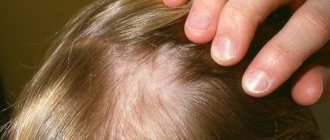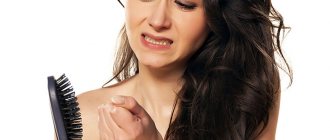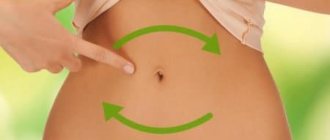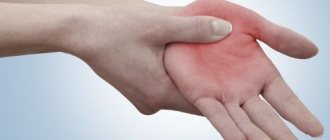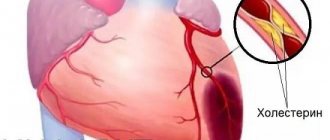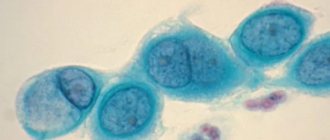Photo: DepositPhotos.com
Men most often suffer from baldness, but women also sometimes suffer from alopecia. There is a fine line between the onset of female pattern baldness and simply severe hair loss. How can a woman determine that she is losing pathologically too much hair? The rate of hair loss per day is up to 150 pieces, but if hair comes out in strands and remains everywhere, and not just in the bathroom drain after washing, you should worry. If bald patches are clearly visible on the head, and the thickness of the braid has become half as large, this is a sign of the onset of alopecia.
Severe baldness in women can be a sign of a malfunction of the body, the presence of hidden infections, inflammatory processes, or lack of vitamins.
All types of hair loss in women can be classified into two types of baldness:
- telogen effluvium
- anagen
Anagen effluvium is when hair falls out suddenly and simultaneously. This type of baldness occurs under the influence of a number of negative factors:
- Long-term use of antibiotics
- Exposure to radiation
- Chemotherapy
Hair follicles stop producing new cells, go into hibernation and completely leave the scalp. When the harmful effects cease, the work of the hair follicles resumes and new hair grows. There is no treatment for anagen type baldness; you just need to protect your hair from negative factors, and it will stop falling out.
Telogen effluvium is a gradual increase in hair loss. This form of baldness does not become noticeable immediately. It may take a long time for the amount of hair on your head to decrease. Chronic telogen effluvium in women is a common problem, especially after the age of 30. In the chronic form, increased hair loss becomes protracted and can last up to several years.
What is female pattern baldness
Baldness or alopecia is the loss of hair localized at certain points on the scalp or throughout the entire scalp.
Despite the fact that hair loss in women is less common than in men , it is a fairly widespread problem, affecting 25% of the female population.
Additionally, the effects of female pattern baldness are more devastating than for males. Of course, this disease in itself does not pose a threat to a woman’s life, but, as you might guess, it is associated with psychological problems.
How does female pattern baldness manifest?
Unlike men, androgenetic alopecia in women, or even baldness, begins with hair loss in the central part : the hair becomes short, thin and colorless, in other words, the hair on the top of the head becomes like fluff. After this transformation, they begin to fall out without being replaced by new ones.
It should be noted that even in the most severe cases, a woman is unlikely to go completely bald, as often happens in men. In addition, hair thinning begins much later, at about the age of forty, versus 18-20 years for men.
Symptoms of the disease
With total alopecia, complete loss of hair on the head occurs. The serious course of the disease affects the eyebrows and eyelashes. The process of loss occurs over a period of 2-3 months, which is the reason for untimely treatment. In this case, the process may first affect the hair on the face, and then only on the head. And vice versa. Women determine hair loss by thickness, as well as by the amount of hair remaining on the comb.
With a rapid progression of the disease, certain factors can speed up the process. Such factors are caused by: frequent washing of the hair with too hot water, the use of gels and other aggressive hair styling products, and the use of cosmetics for eyelashes and eyebrows.
Often the process of baldness is accompanied by headaches, weakness, and increased fatigue. Symptoms are directly related to the cause of baldness.
Classification of female pattern baldness
The most widely used method for classifying female pattern baldness is the Ludwig scale. According to it, there are 3 different degrees of female pattern baldness, in order of importance .
The transition from one degree to another is carried out depending on the density of the hair:
- First type. Hair begins to thin at the top of the head, two or three centimeters from the front line, which usually remains unchanged, unlike men whose hair begins to thin from the forehead and temples.
- Second type. Hair thinning becomes more pronounced, but the balding area remains hairy.
- Third type. The crown of the head becomes completely or almost completely bald, leaving only the front hairline.
Signs of baldness depending on the type of disease
Today, diffuse, alopecia areata and androgenetic alopecia are distinguished.
- Diffuse type of baldness can be recognized by the uniform loss of hair over the entire head. Over time, a strip of skin begins to appear in the crown area, exactly in the middle, while hair actively falls out in the occipital, frontal and parietal regions.
- The nested form is also called focal and can be recognized by the absence of vegetation in certain areas - focal areas.
- Androgenetic alopecia causes thinning of hair in the frontoparietal region.
Causes of hair loss in women
The etiology of baldness in women is very diverse. In fact, hair loss in a woman can be an independent disease or a consequence of another pathology , the result of a transition process , especially stress or taking certain medications.
Below we list the diseases that most often cause hair loss in women .
- Telogen miasma . This is not a real disease. This is a condition in which intense hair loss occurs, which, however, does not lead to the appearance of bald areas on the head. As a rule, it is caused by situations of stress for the body: poor diet, pregnancy and subsequent breastfeeding, weight loss, side effects of certain treatments, such as taking beta blockers, antidepressants, anti-inflammatory non-steroidal drugs.
- Androgenetic alopecia . The most common cause of female pattern baldness. This disease of the hair follicles is caused by genetic factors that make them especially sensitive to androgens (male hormones), which, although in small quantities, are present in the female body.
- Anagen miasma . Pathological hair loss in the growth phase due to impaired metabolic activity of the hair follicle. Most often caused by specific forms of cancer treatment, such as radiotherapy to the head or chemotherapy.
- Hypo-hyperthyroidism . Low blood levels of thyroid hormones, as well as high concentrations, can lead to conditions characterized by hair loss and baldness.
- Systemic lupus erythematosus . A disease in which the immune system mistakenly attacks various organs and tissues of its own body. In some cases, it may affect the hair follicles and scalp.
- Iron-deficiency anemia . Let us recall that anemia is said to occur when the level of hemoglobin in the blood drops below 12 grams per deciliter. Hemoglobin is the main component of red blood cells that can bind oxygen, that is, it ensures the delivery of oxygen to all cells of the body. One of the signs of iron deficiency anemia is hair loss and female pattern baldness.
- Polycystic ovary syndrome . This disease is characterized by a combination of symptoms and clinical signs: absence of menstruation, excess of androgens or male hormones, ovarian cysts. Among various other signs, it should be noted that there is an excess of dehydrotestosterone and, as a result, hair loss and baldness.
- Alopecia areata . Diseases of the scalp, presumably of an autoimmune basis. In this case, the immune system mistakenly attacks and damages hair follicles only in certain areas. The trigger that initiates the autoimmune reactions is unknown, but psycho-physical stress is suspected.
- Traction baldness . This form of baldness is associated with injuries that affect the hair follicles, for example, braids and ponytails that are too tight, excessive chemical treatment of the hair (shampoos, dyes, etc.).
- Scalp infections . The most common fungi are trichophyton, epidermophyton and microsporum.
Prevention
No man is immune from baldness. But competent prevention and a responsible approach to one’s own health can delay the day when surgery is the only way to solve the problem.
To prevent the premature appearance of bald spots, you should treat your hair with care, wash it with sulfate-free mild shampoo, and regularly massage your scalp. Increased attention must be paid to the emotional and mental background and treatment of infectious diseases. An important point is adherence to a physical activity regime.
We must not forget that the trigger for the development of baldness is often vitamin deficiency and deficiency of certain microelements. In this regard, you need to eat right, eat more fresh fruits and vegetables. Basic preventative measures will help preserve your hair and ensure thick hair.
Baldness is a common problem among the male population, especially in men over 40 years of age. There are many types of baldness in men, as well as many reasons why hair begins to fall out.
Almost 70% of men suffer from this disease. But before starting treatment, it is necessary to establish the cause of the disease. If the cause is removable, then the problem of baldness may no longer bother you.
Risk factors – genes and nutritional deficiencies
The elements listed below constitute risk factors for hair loss and subsequent baldness in women:
- Family History . Women who have both parents with hair loss problems are at greater risk of losing their hair.
- Inappropriate and/or excessive hair care . Too often using hair cosmetics (shampoos, dyes, etc.) or using products that are not appropriate for your hair type leads to an increased risk of baldness.
- Insufficient or poor nutrition . Poor nutrition and lack of nutrients and mineral salts, primarily vitamins and iron, can increase the risk of baldness.
Traditional methods of treating baldness
As a rule, folk remedies include various masks that increase blood flow to the follicles and provoke hair growth. This method is effective only if the follicles have not died, but are simply in a dormant state.
Such masks usually use agents that cause a slight burning, tingling, and warmth. For example, red pepper, garlic, mustard powder, alcohol-containing products.
You should add dried fruits, nuts, seafood, fruits and vegetables to your diet, containing vitamins, minerals, and valuable oils for hair benefits.
You can use cosmetics: masks, shampoos, balms containing oils, vitamins, proteins, plant extracts, panthenol. These same products may contain components that enhance blood circulation: menthol, camphor, alcohol, etc.
Baldness is the process of pathological hair loss, resulting in the formation of bald patches. Sometimes the hair simply becomes thinner and creates the effect of reducing the volume of the hairstyle.
Remedies to combat hair loss in women
The main step in treating baldness is an accurate diagnosis, that is, determining the cause of hair loss, and then moving on to targeted therapy.
So, in the case of androgenetic alopecia, treatment is carried out using:
- Antiandrogen drugs. That is, active substances that reduce the production of androgens in the ovaries. Basically, birth control pills that do not contain progestin are used.
- Inhibitors of the enzyme 5-alpha reductase type 2. As a rule, together with contraceptive drugs.
The only drug that has shown real effectiveness in stimulating hair growth is Minoxidil . It is used in the treatment of hypertension, but it has the “side effect” of excessive hair growth, and for this reason it began to be used in a 2% aqueous solution applied to the head.
Surgical methods:
- Hair transplantation. It involves moving small areas of skin with healthy hair to bald areas.
- Reduce bare areas. It consists of surgically removing bald areas, followed by replacing adjacent areas of the head with skin.
Basic treatment methods
To treat baldness use:
- Cosmetical tools. Anti-baldness shampoos are not able to completely stop the process of hair loss. However, they are excellent for preventing the disease. They contain plant extracts that improve the hair structure and saturate it with proteins.
- Diet therapy. To restore normal hair growth, you need to change your diet. It is important to focus on products enriched with vitamins A, B, C, and iron. The patient should exclude animal fats, alcohol, flour, marinades, smoked foods and other foods that cause irritation to the digestive organs.
- Biologically active additives and vitamins. Such complexes should be selected by the attending physician. This will avoid oversaturation of the body with certain microelements.
- Drug therapy. It is carried out in a course, although the first results can be assessed after 5-10 months. To treat baldness, drugs are used that affect the cause of the disease. But there are also remedies that can stop the formation of baldness and accelerate hair growth. Among the most popular drugs for baldness, experts highlight Minoxidil and Finasteride.
- Medical cosmetology. Mesotherapy and plasma therapy procedures are considered useful. The first involves injecting vitamin cocktails under the scalp. To obtain a lasting result, you need to complete a course consisting of 4-6 procedures. During plasma therapy, the patient's platelet-rich plasma is injected into the soft tissues of the head. The maximum possible effect is achieved only after completing 6 procedures.
- Hair transplantation. The most effective method for baldness. The doctor performs a hair transplant from the donor area to the areas affected by alopecia. The procedure is performed using the following technologies: HFE, FUT and FUE. In the first case, we are talking about a non-surgical method. The doctor extracts healthy hair follicles and transplants them to the required area using an implanter. The hair is implanted at an optimal angle, which ensures the correct direction of growth. This transplant technique for baldness does not leave scars, and all the consequences of the intervention disappear in just a couple of days. The FUT method requires the removal of a piece of tissue with a hairy covering. Then it is crushed into separate fragments and introduced into the bald areas of the head. A scar remains at the site where the material is taken. Due to the fact that the method is traumatic, the patient will have to undergo long-term rehabilitation. There is still a risk of complications, including decreased sensitivity, swelling, and suppuration. A less painful method is FUE. Transplantation using this technology is carried out with an instrument that removes many small flaps. Thanks to minimal intervention, healing occurs faster. But the FUE method does not eliminate complications. The survival rate of transplanted hair is about 95%.
Baldness is also treated with folk remedies. In the fight against this pathology, pastes based on hops, onions or burdock have proven themselves to be excellent. Extracts of these plants help awaken and strengthen hair follicles. To improve blood flow to the scalp, you can use a mask made from honey and juice
High effectiveness of hair loss treatment is guaranteed if the following recommendations are followed:
- Initially you need to set yourself up for a good result;
- in complex therapy it is important to take multivitamins;
- ointments and cosmetics for baldness must be applied to the entire scalp;
- you need to take antihistamines for periodic hair loss;
- It is advisable to complete the course of treatment completely.
The most important thing is that you should not count on quick results. The first positive changes will be noticeable no earlier than 3 months after the start of therapy, when the hair moves from the sleep stage to the active growth phase.
Postpartum alopecia
Alopecia often begins during pregnancy, after birth. The cause is hormonal and metabolic imbalance. Usually baldness is a temporary phenomenon and as soon as the body recovers, it disappears. Male hormones cause hair loss, while female hormones control it.
During pregnancy, baldness rarely occurs, since the blood is full of estrogens, which provoke the growth of new hair and inhibit the loss of old ones. After the birth of a child, the situation changes dramatically. The amount of estrogen is greatly reduced, and a predominance appears in the direction of male hormones. Old hair begins to actively fall out. The hair on a woman’s head is sharply thinning.
In the later stages of pregnancy, not only the hair, but also the eyelashes and eyebrows begin to thin. The reason is a deficiency of nutrients - B12, iron. This can cause focal, diffuse baldness, affecting different parts of the body. However, all of the above violations are correctable.
Diagnosis of hair loss
Vitamins, drugs that help improve the general condition of the body, hormones, etc. are usually used as medications. Treatment is carried out by dermatologists or trichologists after a detailed examination of the patient.
You should not take any measures to treat alopecia on your own. Since only a qualified specialist (trichologist) can find the cause, establish the form and stage of the disease and prescribe the required treatment.
To make a diagnosis of alopecia you will need...
- Visual inspection of the patient's skin and strands.
- Examination of hair shafts under a microscope.
- Skin biopsy, tests for fungal infections.
- Genetic analysis for the presence or absence of autoimmune diseases.
- General blood test, for syphilis, for hormone levels.
- If necessary, consultations with other specialists are carried out.

